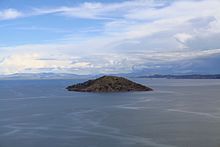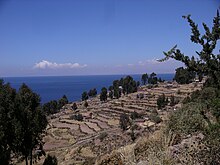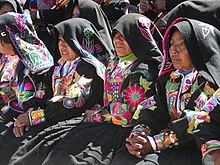Taquile
| Taquile | |
|---|---|
| Waters | Lake Titicaca |
| Geographical location | 15 ° 46 ′ 38 ″ S , 69 ° 41 ′ 3 ″ W |
| length | 5.5 km |
| width | 1.6 km |
| surface | 5.72 km² |
| Highest elevation | 4050 m |
| Residents | 1700 297 inhabitants / km² |
Taquile ( Spanish ) or Intika ( Quechua ) is an island in the Peruvian part of Lake Titicaca , 45 km from the city of Puno . The island is about 5.5 km long and up to 1.6 km wide. The highest point is at 4,050 m above sea level , the largest place at 3,950 m (for comparison, the water surface of Lake Titicaca: 3,810 m).
Taquile has around 1,700 Quechua-speaking residents, called taquileños in Spanish . The Quechua (variant Cusco-Collao Quechua ) is actively spoken by all ages. Many speak Spanish, especially among the younger ones.
history
Intika belonged to the Inca empire since the 15th century . The ruins (on two mountain peaks: Uray K'ari and Hanan K'ari ) probably date from the time of the Tiwanaku culture (approx. 800 AD). The island was one of the last areas in the highlands of Peru to be conquered by the Spanish . For a long time the inhabitants managed to hide from the Spaniards in such a way that they believed the island to be uninhabited. Intika was taken in 1580 for King Charles V , who immediately sold it to Count Rodrigo de Taquila (according to other sources, his name was Pedro Gonzalez de Taquile). The Spanish name of the island goes back to this. Under the Spanish colonial rule , traditional clothing was forbidden, so the Taquileños adopted Spanish peasant clothing . This is her "Indian" costume, which is still used today. In the 1930s Taquile served as a prison island , where, among others, the former Peruvian President Luis Miguel Sánchez Cerro was incarcerated. In 1937 the Taquileños bought back the ownership of the whole island.
economy & Administration and Management
The Taquileños are - similar to the neighboring island of Amantaní - organized in a cooperative that consciously adopts the commandments " Ama suwa, ama llulla, ama qilla " (do not steal, do not lie, do not be lazy ) from the Inca period (or before) ) relates. As a result, the locals forego the presence of a police unit.
The island is supplied by fishing and terrace farming (especially potatoes ). Tourism , which is controlled by the cooperative, has become an important source of income . To this day, this has also prevented any hotel construction that was sought by tourism companies. The approximately 40,000 tourists annually are accommodated in private quarters through central agencies. In this way, the taquileños were able to maintain a relative economic independence.
Touristic
Every year on July 25, the inhabitants of the island celebrate their patron saint on the occasion of the Fiesta de Santiago . At the same time, the Feria artesanal , the fair for handicrafts, takes place on Taquile . The locals wear their traditional costumes and gather in the main square for a ceremony at noon.
Taquile is famous for its weaving and knitting , whose textile products are said to be among the highest quality in Peru. Spinning, weaving, and knitting are mostly done by men. Taquile Textile Art was inscribed on the UNESCO List of Masterpieces of the Oral and Intangible Heritage of Humanity in 2005, and was added to the Representative List of the Intangible Cultural Heritage of Humanity in 2008 .
Special
There is a general ban on dogs and cats on Taquile Island.
Taquile has a radio station powered by generators. However, the municipality has decided to use solar cells .




